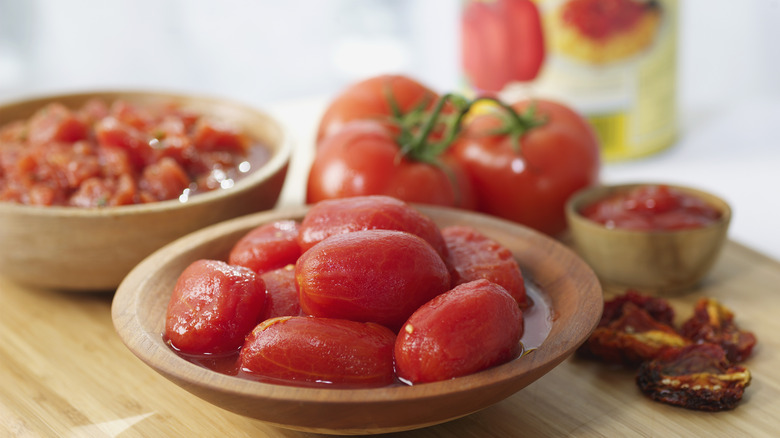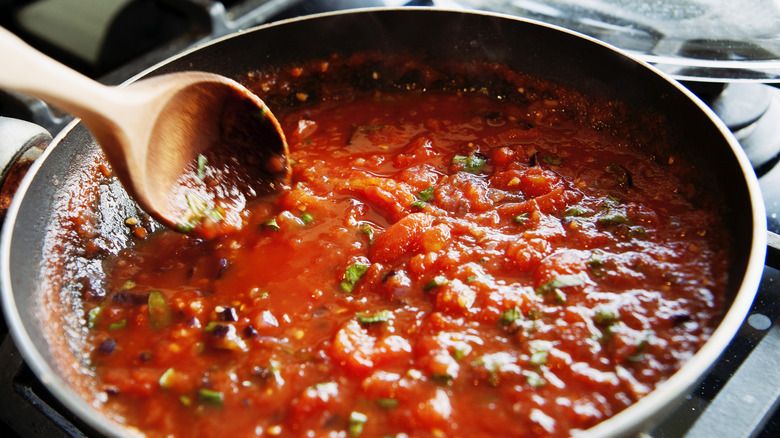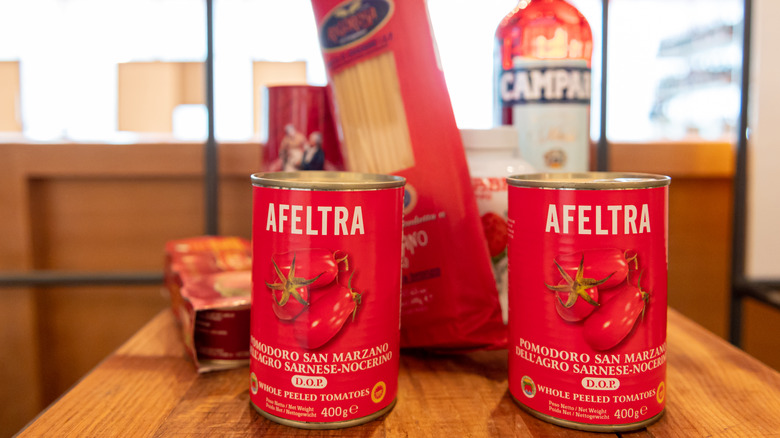What Makes Plum Tomatoes The Absolute Best For Sauces
Reigning as one of the tastiest and most nutritious summer produce pleasures, tomatoes carry an air of clannish mystique in many ways. First of all, they're called a vegetable when they're actually a vine-grown fruit. Then there's an under-explained distinction between heirloom and hybrid tomatoes. And finally, dozens, if not hundreds, of tomatoes bear different names while being essentially the same variety.
Somewhere in the midst of this mater-mania is a perfectly punchy little fruit called a plum tomato, considered the absolute best choice for making tomato-based sauces. Fortunately, it's fairly easy to uncloak the fruity enigma, at least when it comes to making that Italian pasta sauce you're craving.
Simply put, rather than being a single specific tomato, the term plum tomato refers to an overall type. In fact, plum tomatoes are one of the five main types of tomatoes, along with cherry, globe, beefsteak, and oxhearts. The plum tomato type encompasses well-known varieties such as Roma, San Marzano, Italian plum tomatoes, and more.
The distinctions are significant when it comes to making tomato-based sauces, especially Italian ones such as marinara, bolognese, arrabbiata, puttanesca, and pomodoro sauces that can make or break your pasta creations. The characteristic essence of plum tomatoes is what makes them the best choice for sauces: They have thick skins, relatively low water content, a small number of seeds, hearty yet pliable inner flesh, and a nice balance of sweet and tangy flavor.
Identifying plum tomatoes and making sauces
Slight differences exist within the family of plum tomatoes, but generally, you can spot them by their relatively small size and tidy oval shape. They've been described as resembling an egg or football, though some can be more pear-shaped, a bit rounder, or with pointed tips. Common identifying names include Roma and San Marzano but also regional monikers such as Big Mama, Ropreco Paste, and Amish Paste. Descriptors can also reference the intended use. For example, plum varieties can be called paste, cooking, sauce, or processing tomatoes.
Making a classic Italian-style sauce with fresh plum tomatoes is easy, but it does take some care and attention. Since plum tomatoes have those sturdy skins, some chefs recommend peeling them first, accomplished by boiling them for about a minute, and then cooling, peeling, and dicing for the sauce. Others advocate leaving the skins intact while making the sauce, thereby keeping all flavor and nutrition in the pan — and ultimately in your sauce. In that scenario, you would pan-fry the tomatoes until they burst and release their tasty liquids. The skins will then be pliable and easy to remove.
The tomatoes can then be joined by your favorite sauce ingredients, such as olive oil, garlic, onion, oregano, parsley, and crushed red or black pepper. The most important thing is the tomatoes –– which can also be canned or jarred versions that come already peeled.
Choosing canned or jarred plum tomato sauces
It's certainly possible to create homemade tomato sauces from fresh-picked tomatoes, but canned or jarred tomatoes are viable, readily accessible alternatives regardless of the season. Most canned tomatoes are plum varieties, thanks to the well-known resilient texture, which holds up under processing and extended storage.
They can sometimes taste even better than fresh tomatoes because many farmers grow plum tomatoes specifically for canning, leaving them to ripen longer on the vine in prime season before promptly sealing in the fresh flavor and nutrients. By comparison, fresh supermarket tomatoes could easily have been picked before peak ripeness in order to survive and ripen during transportation.
Canned San Marzano tomatoes have become the standard-bearer for making perfect Italian-style sauces. But the variety isn't exclusive to the San Marzano area, and tomato enthusiasts can even buy the seeds for home gardens. Canned or jarred versions provide an affordable option, but keep an eye on labels. If possible, avoid ones using calcium chloride as a preservative, as it can inhibit the tomatoes from properly breaking down into a luscious, flavorful pasta sauce.



